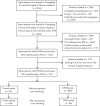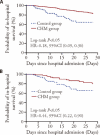Efficacy and safety of Chinese herbal medicine as adjunctive therapy in sepsis patients with bloodstream infection: a propensity-matched analysis
- PMID: 38213255
- PMCID: PMC10774732
- DOI: 10.19852/j.cnki.jtcm.20231204.002
Efficacy and safety of Chinese herbal medicine as adjunctive therapy in sepsis patients with bloodstream infection: a propensity-matched analysis
Abstract
Objective: To investigate the efficacy and safety of Chinese herbal medicine in treating sepsis patients with bloodstream infection.
Methods: A 6-year retrospective study was carried out at a university hospital in China. Adult sepsis patients with bloodstream infection were included. The primary outcome was 28-day mortality after admission. Propensity score method was used to adjust for possible confounding. 28-day mortality was estimated by Kaplan-Meier analysis and compared using the log-rank test. Cox regression analysis was carried out to identify factors impacting in-hospital mortality outcomes.
Results: Following the application of the propensity score method, a total of 176 patients were included. The all-cause 28-day mortality in the control group and Chinese herbal medicine group was 21.6% and 14.8%, respectively. Kaplan-Meier survival analysis showed that Chinese herbal medicine was associated with a lower hazard ratio (HR) in all-cause 28-day death compared with the control group [HR = 0.44, 95% CI(0.22, 0.90), P < 0.05]. The complications were similar between the two groups (P >0.05). Blood-activating and stasis-eliminating herb administration was associated with reduced in-hospital mortality among sepsis patients with bloodstream infection [HR = 0.54, 95% CI(0.34, 0.94), P < 0.05].
Conclusions: Chinese herbal medicine, especially the blood-activating and stasis-eliminating herb, might have certain efficacy and safety in treating sepsis patients with bloodstream infection. Clinicians should prescribe blood-activating and stasis-eliminating herb in treating these two coalescent critical diseases as long as no contraindications exist. However, further studies are needed to validate our results.
Keywords: bacteremia; herbal medicine; medicine, Chinese traditional; propensity-matched analysis; sepsis.
Figures


Similar articles
-
Effects of Chinese herbal medicine therapy on survival and hepatic outcomes in patients with hepatitis C virus infection in Taiwan.Phytomedicine. 2019 Apr;57:30-38. doi: 10.1016/j.phymed.2018.09.237. Epub 2018 Oct 3. Phytomedicine. 2019. PMID: 30668320
-
Complementary Chinese Herbal Medicine Therapy Improves Survival of Patients With Pancreatic Cancer in Taiwan: A Nationwide Population-Based Cohort Study.Integr Cancer Ther. 2018 Jun;17(2):411-422. doi: 10.1177/1534735417722224. Epub 2017 Aug 3. Integr Cancer Ther. 2018. PMID: 28774207 Free PMC article.
-
Complementary Chinese herbal medicine therapy improves survival of patients with gastric cancer in Taiwan: A nationwide retrospective matched-cohort study.J Ethnopharmacol. 2017 Mar 6;199:168-174. doi: 10.1016/j.jep.2017.02.004. Epub 2017 Feb 3. J Ethnopharmacol. 2017. PMID: 28163114
-
Chinese herbal medicine for bone health.Pharm Biol. 2014 Sep;52(9):1223-8. doi: 10.3109/13880209.2014.884606. Epub 2014 Jun 25. Pharm Biol. 2014. PMID: 24963946 Review.
-
[Overview of systematic reviews of Chinese herbal injections for sepsis].Zhongguo Zhong Yao Za Zhi. 2023 Apr;48(7):1962-1975. doi: 10.19540/j.cnki.cjcmm.20230117.501. Zhongguo Zhong Yao Za Zhi. 2023. PMID: 37282973 Review. Chinese.
Cited by
-
A Direct Relationship Between 'Blood Stasis' and Fibrinaloid Microclots in Chronic, Inflammatory, and Vascular Diseases, and Some Traditional Natural Products Approaches to Treatment.Pharmaceuticals (Basel). 2025 May 12;18(5):712. doi: 10.3390/ph18050712. Pharmaceuticals (Basel). 2025. PMID: 40430532 Free PMC article. Review.
References
-
- Levy MM, Fink MP, Marshall JC, et al.. 2001 SCCM/ESICM/ACCP/ATS/SIS international sepsis definitions conference. Intensive Care Med 2003; 29: 530-8. - PubMed
-
- Fleischmann C, Scherag A, Adhikari NK, et al.. Assessment of global incidence and mortality of hospital-treated sepsis. Current estimates and limitations. Am J Respir Crit Care Med 2016; 193: 259-72. - PubMed
-
- Biwersi C, Hepping N, Bode U, et al.. Bloodstream infections in a German paediatric oncology unit: prolongation of inpatient treatment and additional costs. Int J Hyg Environ Health 2009; 212: 541-6. - PubMed
MeSH terms
Substances
Grants and funding
- 2019KT1317/Clinical Research Program of Guangdong Provincial Hospital of Chinese Medicine: Exploring the Epidemiological Characteristics and Screening Key Prognostic Indicators of Sepsis Patients with Bloodstream Infection
- 2017B030314176/which is a sub-project of Guangdong Provincial Key Laboratory of Research on Emergency in TCM
LinkOut - more resources
Full Text Sources
Medical
